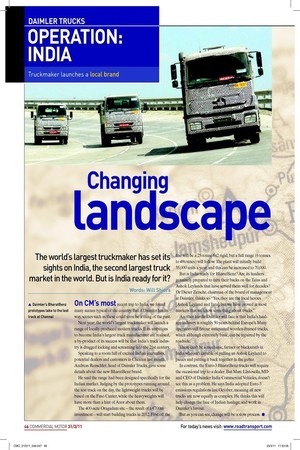andscape
Page 36

If you've noticed an error in this article please click here to report it so we can fix it.
The world’s largest truckmaker has set its sights on India, the second largest truck market in the world. But is India ready for it?
Words: Will Shiers
On CM’s most recent trip to India, we found many scenes typical of the country. But if Daimler has its way, scenes such as these could soon be a thing of the past.
Next year, the world’s largest truckmaker will launch a range of locally produced modern trucks. If its ambitions to become India’s largest truck manufacturer are realised, a by-product of its success will be that India’s truck industry is dragged kicking and screaming into the 21st century.
Speaking to a room full of excited Indian journalists, potential dealers and customers in Chennai last month, Andreas Renschler, head of Daimler Trucks, gave some details about the new BharatBenz brand.
He said the range had been designed speciically for the Indian market. Judging by the prototypes running around the test track on the day, the lightweight trucks will be based on the Fuso Canter, while the heavyweights will have more than a hint of Axor about them.
The 400-acre Oragadam site – the result of a €700m investment – will start building trucks in 2012. First off the line will be a 25-tonne 6x2 rigid, but a full range (6 tonnes to 49tonnes) will follow. The plant will initially build 35,000 units a year, and this can be increased to 70,000.
But is India ready for BharatBenz? Are its hauliers genuinely prepared to turn their backs on the Tatas and Ashok Leylands that have served them well for decades? Dr Dieter Zetsche, chairman of the board of management at Daimler, thinks so. “Yes, they are the local heroes [Ashok Leyland and Tata], but we have proved in most markets that we know something about trucks.” Another hurdle Daimler will face is that India’s haulage industry is roughly 50 years behind Europe’s. Many operators still favour antiquated wooden-framed trucks, which although extremely basic, can be repaired by the roadside.
There can’t be a mechanic, farmer or blacksmith in India who isn’t capable of pulling an Ashok Leyland to pieces and putting it back together in the gutter.
In contrast, the Euro-3 BharatBenz trucks will require the occasional trip to a dealer. But Marc Llistosella, MD and CEO of Daimler India Commercial Vehicles, doesn’t see this as a problem. He says India adopted Euro-3 emissions regulations last October, meaning all new trucks are now equally as complex. He thinks this will help change the face of Indian haulage, and work in Daimler’s favour.
But as you can see, change will be a slow process. ■









































